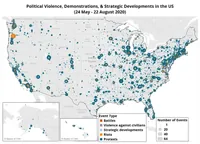Francine Weakens After Battering Louisiana Coast, Flood Threats Persist
Tropical Storm Francine, formerly a Category 2 hurricane, hit Louisiana, causing widespread power outages and flooding. The storm continues northward, threatening multiple states with heavy rainfall and potential flash floods.

Tropical Storm Francine, which made landfall in Louisiana as a Category 2 hurricane on September 11, 2024, has weakened as it moves northward, leaving a trail of destruction and ongoing flood threats in its wake. The storm struck the Louisiana coast with winds reaching 100 mph (155 kph), impacting a region still recovering from devastating hurricanes in 2020 and 2021.
Jeff Landry, Louisiana's governor, announced the deployment of National Guard units to affected areas. The Guard's response includes the provision of food, water, and the use of nearly 400 high-water vehicles, approximately 100 boats, and 50 helicopters for potential search-and-rescue operations. This deployment showcases the crucial role the National Guard has played in hurricane response since the early 20th century.
The storm's impact was immediately felt across southeastern Louisiana, with power outages affecting over 362,546 homes and businesses. Morgan City, a community of about 11,500 residents situated on the banks of the Atchafalaya River, experienced the storm's fury firsthand. The city, founded in 1860 and originally named "Tiger Island," serves as a gateway to the Gulf of Mexico for the shrimping and oil industries.

Alvin Cockerham, Morgan City's fire chief, reported conditions worse than anticipated, necessitating the withdrawal of emergency vehicles due to dangerous conditions. Local resident Laura Leftwich described the storm's intensity, noting the loss of birdhouses and the overflow of water in the streets.
Francine's development was fueled by the exceptionally warm waters of the Gulf of Mexico, a trend linked to climate change. The Gulf's rising average water temperature has been a concern for climatologists and meteorologists alike. As the storm moves inland, it's expected to weaken further to a tropical depression, but the threat of heavy rainfall and potential flash flooding persists across multiple states.
The National Hurricane Center predicts rainfall amounts of 4 to 8 inches (10 to 20 centimeters) across much of Louisiana and Mississippi, with some areas potentially receiving up to 12 inches (30 centimeters). This heavy precipitation, combined with storm surge, poses a significant threat to Louisiana's coastal wetlands, which typically act as a natural buffer against such events.
"Much of Louisiana and Mississippi could get 4 to 8 inches of rain, with the possibility of 12 inches in some spots."
In response to the emergency, President Joe Biden granted an emergency declaration to expedite federal assistance to Louisiana. Neighboring Mississippi has also taken precautionary measures, with the state's Emergency Management Agency distributing over 100,000 sandbags in southern regions and numerous school districts announcing closures.
Francine marks the sixth named storm of the 2024 Atlantic hurricane season, which officially runs from June 1 to November 30. Since the mid-19th century, Louisiana has experienced 57 hurricanes tracking over or making landfall in the state, including some of the strongest and costliest storms in U.S. history, such as Hurricane Katrina in 2005.
As Francine continues its northward trajectory, residents in affected areas are urged to remain vigilant. The storm's outer bands may spawn tornadoes, a common occurrence in hurricanes. Additionally, the rapid movement of the storm, at 17 mph (26 kph), while helping to reduce overall rainfall totals, can lead to sudden and intense downpours that may catch communities off guard.
The coming days will be crucial for recovery efforts and assessing the full extent of Francine's impact on the Gulf Coast region. As climate change continues to influence weather patterns, the frequency and intensity of such storms may increase, underscoring the importance of robust disaster preparedness and response strategies.


































